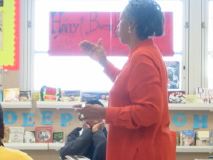
A
Friend of Their Minds: Capitalizing on the Oral Tradition of My
African American Students
CLASS
ANATOMY
YVONNE
DIVANS HUTCHINSON
KING-DREW
MEDICAL MAGNET SCHOOL
LOS ANGELES, CA
Yvonne
Divans Hutchinson is a National Board certified teacher who has focused
for many years on developing strategies to engage all her students in
substantive discussions of literary texts and the issues those texts
raise for their own lives. In this approach, she builds on the oral
traditions of her students African-American and Latino cultures and
seeks to support the development of their literacy skills through high
standards, explicit expectations, and rigorous literature experiences.
Her online "class anatomy"- a documentation and analysis of
one instructional period - juxtaposes video clips with commentary and
samples of classroom documents. In the video clips, Hutchinson reflects
on her expectations for the class, a student orally presents the "class
scribe" notes from the previous day, the students engage in small
group and large group discussion about a racially charged literary selection
that had been assigned the night before, and after the class, four students
reflect on their experiences in Hutchinson's classroom, and how her
rigorous approach and emphasis on dialogue and diversity prepares them
for other academic work.
Context and Reflections
- Thinking with Text
- Project Snapshot
- Teaching Context: School and Students
- Video: What audiences of this work should know about Yvonne's teaching, and her journey to develop this approach.
- Narrative: Where I Began/ Where I Begin
Materials and Strategies
- Strategies for Promoting Literate Discourse
- Question-Answer Relationships • Student Response Sample
- Anticipation Guide
- Reading Response Prompt
- Class Scribe Prompt • Class Scribe Writing Sample
- Informal Reading Assessment
Video:
Entire class session (2 hours)
Entire reflective interview (1 hour)
Class Anatomy Timeline
Class Session: June 2002
1.
Setting Goals for the Class Session
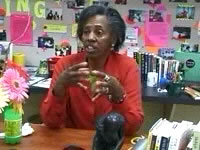
YDH tells what she expects to see as evidence of oral discourse as students discuss a memoir by Willie Ruff, "A Call to Assembly." . (4:00)
2.
Describing the Previous Day's Work
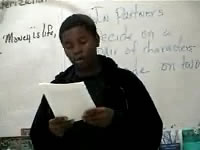
DJ, class scribe for the previous day, delivers his lively and humorous narrative of the class activities for that day. At the end of the report, his peers evaluate both the report and his delivery. Daily class scribe reports and related instructional materials or handouts are kept in a Class Notebook in the classroom. (3:03)
(View the Class Scribe Prompt, or another student's Class Scribe Writing Sample)
3.
Engaging in Small Group Discussion
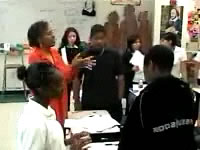
Responding to teacher's directions to honor diversity in their choices of discussion partners, students meet in duos or trios to share their responses to the Anticipation Guide for "A Call to Assembly." (6:03)
4. Connecting
to Larger Societal Issues
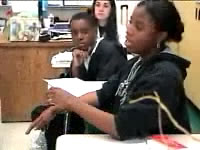
Andrea speaks passionately about leaders from African American and Hispanic communities and the difficulties of effecting change. She ends her talk with an indictment of Black and Hispanic gangs and the diviseness among (and between) the two racial groups. (3:41)
5. Making Explicit
Reference to the Text
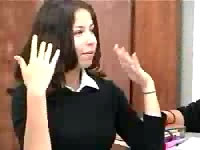
Gladis begins the discussion of a pivotal moment in the text, questioning the use of the perjorative "N" word. Tiffany shows discernment in her analysis of the ten year old Ruff's motive in quitting his job. Other students voice their ideas, and the conversation culminates with Ashlan sharing her knowledge of sign language. (3:41)
6.
Reflecting on the Impact of Diversity, Rigor, and Discourse
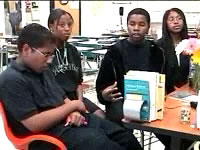
Dejean, Andrea, Tiffany reveal how the requirement to honor diversity in their classroom interactions not only broadened their perspective, but resulted in new friendships. (1:44)